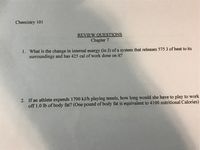
Chemistry
10th Edition
ISBN: 9781305957404
Author: Steven S. Zumdahl, Susan A. Zumdahl, Donald J. DeCoste
Publisher: Cengage Learning
expand_more
expand_more
format_list_bulleted
Question

Transcribed Image Text:Chemistry 101
REVIEW QUESTIONS
Chapter 7
1. What is the change in internal energy (in J) of a system that releases 575 J of heat to its
surroundings and has 425 cal of work done on it?
2. If an athlete expends 1700 kJ/h playing tennis, how long would she have to play to work
off 1.0 lb of body fat? (One pound of body fat is equivalent to 4100 nutritional Calories)
Expert Solution
This question has been solved!
Explore an expertly crafted, step-by-step solution for a thorough understanding of key concepts.
This is a popular solution
Trending nowThis is a popular solution!
Step by stepSolved in 3 steps with 3 images

Knowledge Booster
Learn more about
Need a deep-dive on the concept behind this application? Look no further. Learn more about this topic, chemistry and related others by exploring similar questions and additional content below.Similar questions
- Pelcomtel fall 2020-Compatibility Mode Word Search eferences Mailings Ma Ma djaH 15 E E AaBbCeI AaBbCd AaBbC AaBbC Aab - -E E & EE 1 Normal 1 No Spac. Heading1 Subte Paragraph sayas 14 Which of the following is an example of something with potential energy 1 a ball falling through the air 2 throwing a dart at a dart board 3. a ball rolling down a slide 4 an arron flving through the air a boulder at the top of a clitfarrow_forward4. Calculate the standard heat of formation of calcium carbide (CaC) from its elements in kJ/mol using the following thermochemical equations. (hint come up with the overall equation first) Ca(s) + 2H₂O ⇒ Ca(OH)2(s) + H₂(g) 2C(s) + O2(g) → 2CO CaO + H₂O⇒ Ca(OH)2() 2H2(g) + O2(g) → 2H₂O) CaO) + 3C,,→ CaCs) + CO ΔΗ°= - 414.79 kJ ΔΗ°= - 221.00 kJ ΔΗ°= - 65.19 kJ ΔΗ°= - 571.80 kJ AH°= + 462.30 kJ 1arrow_forwardMaterial: Block Mass: Соpper 5.0 g 10.0 g Heating Duration: 2 s Нeat Reset Tinitial T final 20.0 °C 71.9 °C 100 J has been transferred to the block. Experiment Complete Click Reset for a new experiment. Specific heat capacity is a measure of the quantity of heating required to raise 1 g of a substance 1 °C (1 K). Specific heat capacity can be calculated from the equation quantity heating (J) mass (g) x AT(°C) specific heat capacity (J g1 °C) = m x AT Use the following settings: Material: Copper Heating Duration: 2.0 s Block Mass: 5.0 g Run the experiment and calculate the value of the specific heat capacity for copper. ]× Jg°c!arrow_forward
- Thefollowing combustion reaction was carried out using 3.88 g O2 and excess CH4.CH4 + 2O2 → CO2 + 2H2O.After the reaction was complete, the value of qsurr was determined from temperature measurements made in the surroundings. It was found that qsurr = +53.5 kJ. a. What is the value of qrxn? (This means the same as qsys.)b. Calculate the moles of reaction that was present in this experimental run.c. Divide the qrxn by the moles of reaction to determine ∆rH. Pay careful attention tothe sign, units, and sig figs of your answer.arrow_forwardX du.co Ce... 3 O E Aktiv Chemistry Metal What is the identity of a 100.0 g sample of metal that, upon absorbing 4680 J of heat, increases in temperature by 52.0 °C? Aluminum Copper Iron Magnesium Silver Tin Titanium $ R F5 Specific Heat Capacity J/(g-°C) 0.90 % 5 x + F6 T 0.38 0.45 1.00 0.23 0.32 0.52 F7 Y H F8 & Question 4 of 12 7 F9 * 8 F10 K ( 9 F11 O A) Mg B) Al C) Ti D) Fe ) F12 P PrtScr + Insert Hô Delete Backspace 1 PgUparrow_forward5. Use standard heats of formation and the following equation to determine the enthalpy of formation of C₂H() ΔΗ, = -3127 kJ 2C₂H6(g) +70₂(g) ⇒ 4CO2(g) + 6H₂O)arrow_forward
- Reaction: Combustion of CH4 with excess O2 mass = 1.6 g delta T = 1.3 oC heat capacity of bomb calorimeter = 11.3 kJ/ oC what is qrxn and delta Erxn?arrow_forwardIncreasing Energy 80 60 40 40 20 kJ/mol Reactants II A + B Reactants IV V Products Progress of Reaction. C + D Products Using the energy diagram above, approximate the AAG* for the reaction? Enter numeric value only and use units kJ/mol.arrow_forward
arrow_back_ios
arrow_forward_ios
Recommended textbooks for you
 ChemistryChemistryISBN:9781305957404Author:Steven S. Zumdahl, Susan A. Zumdahl, Donald J. DeCostePublisher:Cengage Learning
ChemistryChemistryISBN:9781305957404Author:Steven S. Zumdahl, Susan A. Zumdahl, Donald J. DeCostePublisher:Cengage Learning ChemistryChemistryISBN:9781259911156Author:Raymond Chang Dr., Jason Overby ProfessorPublisher:McGraw-Hill Education
ChemistryChemistryISBN:9781259911156Author:Raymond Chang Dr., Jason Overby ProfessorPublisher:McGraw-Hill Education Principles of Instrumental AnalysisChemistryISBN:9781305577213Author:Douglas A. Skoog, F. James Holler, Stanley R. CrouchPublisher:Cengage Learning
Principles of Instrumental AnalysisChemistryISBN:9781305577213Author:Douglas A. Skoog, F. James Holler, Stanley R. CrouchPublisher:Cengage Learning Organic ChemistryChemistryISBN:9780078021558Author:Janice Gorzynski Smith Dr.Publisher:McGraw-Hill Education
Organic ChemistryChemistryISBN:9780078021558Author:Janice Gorzynski Smith Dr.Publisher:McGraw-Hill Education Chemistry: Principles and ReactionsChemistryISBN:9781305079373Author:William L. Masterton, Cecile N. HurleyPublisher:Cengage Learning
Chemistry: Principles and ReactionsChemistryISBN:9781305079373Author:William L. Masterton, Cecile N. HurleyPublisher:Cengage Learning Elementary Principles of Chemical Processes, Bind...ChemistryISBN:9781118431221Author:Richard M. Felder, Ronald W. Rousseau, Lisa G. BullardPublisher:WILEY
Elementary Principles of Chemical Processes, Bind...ChemistryISBN:9781118431221Author:Richard M. Felder, Ronald W. Rousseau, Lisa G. BullardPublisher:WILEY

Chemistry
Chemistry
ISBN:9781305957404
Author:Steven S. Zumdahl, Susan A. Zumdahl, Donald J. DeCoste
Publisher:Cengage Learning

Chemistry
Chemistry
ISBN:9781259911156
Author:Raymond Chang Dr., Jason Overby Professor
Publisher:McGraw-Hill Education

Principles of Instrumental Analysis
Chemistry
ISBN:9781305577213
Author:Douglas A. Skoog, F. James Holler, Stanley R. Crouch
Publisher:Cengage Learning

Organic Chemistry
Chemistry
ISBN:9780078021558
Author:Janice Gorzynski Smith Dr.
Publisher:McGraw-Hill Education

Chemistry: Principles and Reactions
Chemistry
ISBN:9781305079373
Author:William L. Masterton, Cecile N. Hurley
Publisher:Cengage Learning

Elementary Principles of Chemical Processes, Bind...
Chemistry
ISBN:9781118431221
Author:Richard M. Felder, Ronald W. Rousseau, Lisa G. Bullard
Publisher:WILEY